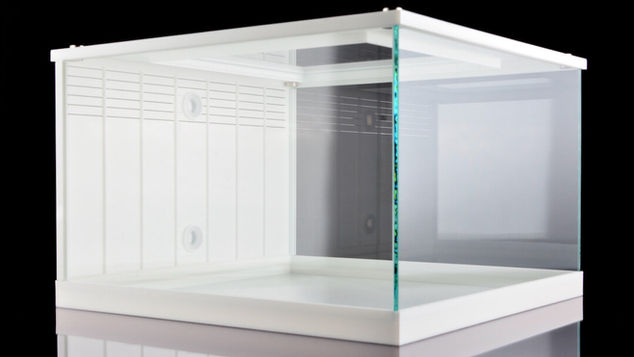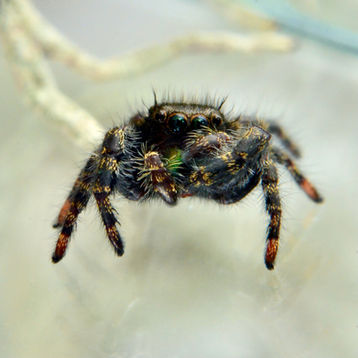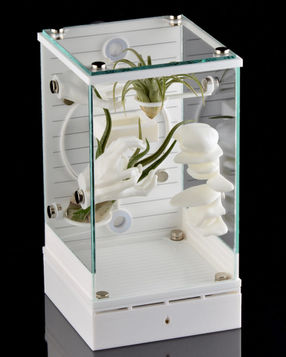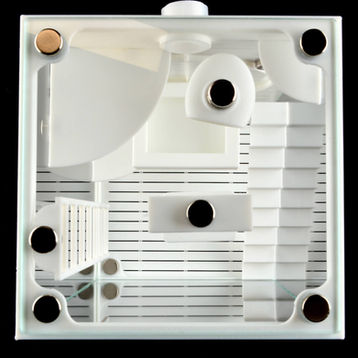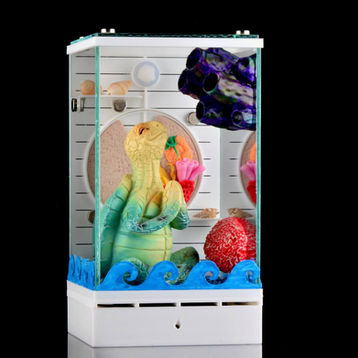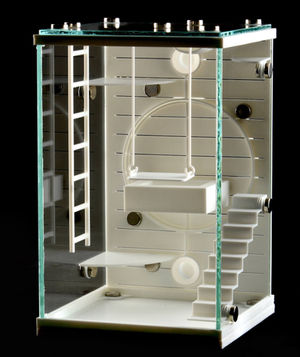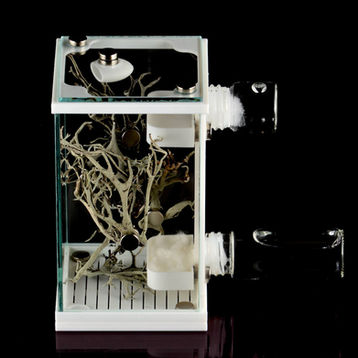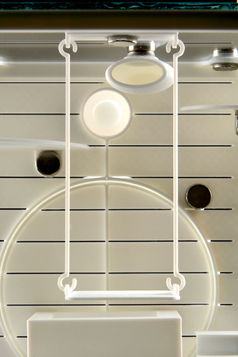Shop global, We ship worldwide.
Spider Enclosure Ventilation, Humidity & Temperature
Ensuring the best environmental conditions for our pet spiders and tarantulas is tricky. On top of that, all the information found on many care sheets can be misleading or hard to achieve, mainly if we use the cheap equipment sold in pet stores to measure such parameters (very unreliable readings); we can easily make mistakes if we don't understand the circumstances that determine how temperature, airflow (ventilation) and humidity interact with each other; in fact, this is the key; understand how each affects and modifies the other. Often, while trying to achieve these "perfect" conditions, we tend to cause more stress and harm to our pets.
Before we dig deep into this topic, let's simplify it with a straightforward statement:
Spiders and Tarantulas are remarkably adaptable creatures. They can thrive in a range of environmental conditions. For most species, the average room temperature and humidity in our homes are perfectly suitable, provided they are housed in enclosures with proper cross ventilation and access to fresh water (such as a water dish). It's important not to let unnecessary concerns about temperature and humidity levels add to the stress of caring for your pet.
But what are the average room conditions? Houses have different thermostat settings and different humidity levels depending on the geographical zone and people's choices; if you are wearing light clothes and feel comfortable inside your house, then your spider is likely comfortable; if you need to put on lots of sweaters and blankets, then this may be cold for them, and if you are sweating a lot and feeling overwhelmed by humidity this will also mean it is likely hot and wet for your spider; in general your spider will adapt well in an enclosure placed at room temperatures between 19CºC up to 30Cº (67Fº up to 85F)º with the sweet spot being between 21Cº to 25Cº (70Fº to 77Fº) and the room air relative humidity between 40% to 60%. Please notice that we are talking about the room around the enclosure.
Ready to dig deeper? Let's do it!
There are three areas that we need to monitor and set up correctly to achieve ideal conditions:
-
The air around the enclosure. The air temperature, humidity, and air movement in the room around the enclosure.
-
The air inside the enclosure. This is the space or empty volume between the substrate and walls inside the enclosure.
-
The substrate inside the enclosure. This is the soil or media used in your enclosure, which plays a significant role.
The temperature and humidity of each area, combined with the airflow or exchange of air between these areas, determines if we will achieve the proper conditions. As we break down each parameter, we will keep referencing the interaction with the other areas.
Enclosure Ventilation and Air-Flow:
Ventilation refers to the movement of air inside and through the enclosure. In general, high-ventilation enclosures can quickly exchange the air inside with fresh air from outside. Consequently, such will have a humidity and temperature similar to the one found outside the enclosure and dry up faster. Contrarily, enclosures with less ventilation exchange air at a much lower rate; consequently, they can retain higher humidity and temperature levels.
Stagnant air that is humid and warm can quickly become a breeding ground for mould and bacteria. Different species may require more airflow or less, so striking a balance is essential.
How do we make air move and flow throughout an enclosure?
Airflow is often misunderstood, as people assume that air will magically move through the ventilation openings in the enclosure. However, more is needed than openings to effectively move and exchange air, such as a source of energy that creates a pressure difference. There are different mechanisms to achieve this.
Air moves because of differences in air pressure. It flows from areas of higher pressure to lower pressure, seeking to equalize the pressure difference. This principle is known as the "pressure gradient force."
There are three easy ways to change the pressure of air. First, with the help of mechanical devices that use compression, such as fans, blowers, pumps etc. Second and third, by changing air density with temperature and humidity. For example, warmer or less dense air rises, and colder or more dense air sinks. Similarly, humid air is less dense and rises; dry air is denser and sinks.
In theory, it is possible to have an enclosure with tons of ventilation openings. Still, suppose the air outside the enclosure is not moving, or the temperature and humidity of the air inside and outside has no difference in density or pressure. In that case, the air could be stagnant with zero movements, and no ventilation will happen. Even if we have the proper humidity and temperature requirements in this stagnant air, we will still lack fresh airflow containing oxygen and moving through our spiders' book lungs and tracheae. This is because they don't have mechanical lungs that move air in and out of their body. Instead, they are passively dependent on the presence of oxygen and humidity in the immediate air surrounding them, hence why, for some species, good airflow is so important.
What practical scenarios can we conclude from this?
Placing a fan in the room with the enclosure causes air to move, creating an airflow inside the enclosure due to pressure changes resulting from "Bernoulli's principle." However, we don't commonly see enclosures with fans.
If the air inside the enclosure is warmer or more humid, it will naturally rise and flow upward and through openings at the top, allowing fresh air to enter from the bottom. This is commonly known as the "Stacking-effect." Which is defined as the air movement into and out of the enclosure through openings, gaps, screens or lines, resulting from air buoyancy. Buoyancy occurs due to air density differences resulting from temperature and moisture changes. This effect can work in combination with cross-ventilation to maximize airflow.
What is Cross- ventilation? - Cross ventilation refers to the natural or mechanical process of bringing fresh air into a space through an opening on one side and allowing stale air to exit on the opposite side. The benefit is that airflow keeps items dry and reduces mould outbreaks. Therefore, planning the placement of the enclosure ventilation holes, lines, or openings is crucial.
This diagram illustrates various ventilation scenarios based on placement and their response to natural air movement caused by buoyancy. It is clear from the diagram that combining top ventilation with bottom ventilation can result in faster air movement compared to only having side openings. Additionally, the diagram shows that ventilation only on the sides, especially towards the bottom, generates the least airflow.
The arrow indicates the airflow direction, while the colour gradient from red to green indicates the strength of the flow. The purple cross indicates areas of stagnant air or low flow, which can trap warm or moist air and contribute to forming gradients. The ventilation openings are marked in blue, while the enclosure is outlined in black.

Proper ventilation within a hobby enclosure is typically achieved by strategically placing ventilation inlets and outlets. The air movement is mainly driven by the energy exchange resulting from the moisture evaporation from within the substrate inside the enclosure, which makes the air inside less dense. The rising moist air escapes from the top openings, while fresh air is drawn in from the lower openings. The evaporation rate of water depends on the substrate's relative humidity and temperature. Therefore, regulating humidity, temperature, and vent openings in the enclosure determines the air exchange rate. Different species have different humidity, and airflow requirements, so varying combinations of ventilation placement and substrate moisture may be necessary.
Humidity & Moisture:
After reading all about ventilation, it is clear that the humidity inside the enclosure plays a significant role in airflow, which drives the buoyancy needed for air to rise and move. But don't worry; hydrating an enclosure is easy. However, new hobbyists should avoid obsessing over humidity levels and instead focus on providing a healthy environment for their pets first.
Firstly, it is essential to note that while most spiders and tarantulas require mid to high humidity levels in their enclosure, keeping the enclosure dry is equally essential. Allowing the substrate to dry out before adding water can help prevent bacterial, fungal, and parasitic infections in your pet.
How do we lower or raise humidity?
To lower humidity levels, pet owners can increase ventilation in the enclosure and allow the substrate to dry out a bit. Removing sphagnum moss for a while can also help lower humidity levels. Conversely, to increase humidity levels, moisten the substrate in the tank, but ensure that it is not seeping water. Adding water to the water bowl can also help increase humidity levels as it evaporates. Adding sphagnum moss to the enclosure can also help maintain humidity levels. It is crucial to use the correct type of substrate to maintain humidity in the enclosure. If the substrate dries out quickly, consider changing or mixing it with another substrate that can retain more water for extended periods. Additionally, you can add a humidifier to your home if you live in a dry climate or if humidity levels are consistently low, as it is much easier to regulate the overall humidity of a large area vs a small volume.
Remember, it is important not to obsess over precise humidity levels. Accurate humidity levels are challenging to measure with cheap gauges, and requirements listed on care sheets may not account for local climate conditions. In addition, most species can thrive at a range of humidity levels, and overly humid enclosures can harm some spiders. Instead, good husbandry practices are more important than precise humidity levels. Providing enough substrate depth for burrowing, keeping a water bowl filled with fresh water at all times, providing good ventilation, and using moist soil for tropical species are all critical factors to consider when managing humidity levels.
When you keep pets in enclosures, the amount of moisture or humidity inside them can be much higher than in your house. So, spraying water inside the enclosure daily can make the humidity level very high and dangerous for your pet. Too much moisture can even cause harm to your pet's health.
Tip: To provide water for your enclosure, simulate a light rain by watering the substrate rather than wetting the entire enclosure. This allows the substrate to absorb water, which will gradually release moisture into the air.
For slings, moisture is vital. A water bowl and moist substrate can help prevent dehydration. Some spider species, like jumping spiders, may drown if exposed to puddles of water; for them, tiny drops of water from a fine mist spray bottle or wet-soaked cotton balls may be safer. In general, avoiding a sponge or anything in the water bowl is best as it may harbour bacteria and fungi. If you are worried about prey (like crickets) drowning in the water bowl, add a small stone so they can climb out in case they fall in. If you use cotton to provide drinking water, it constantly needs to be replenished for a clean, fresh one.
Conclusion: Humidity inside an enclosure is best managed by carefully selecting the amount of ventilation the enclosure can provide, as well as by controlling the humidity level of the air outside the enclosure and the amount of water retained and evaporated by the substrate. It is essential to remember that the air near the substrate will be more moist and humid than the air closer to the ventilation openings. Tarantulas that burrow and build their homes underground receive most of their humidity from the substrate, not the air above.
Temperature and Heating:
As mentioned at the beginning of the guide, generally, most setups do well at room temperatures within the low and high averages of a home, ranging from 19°C to 30°C (67°F to 85°F), with the sweet spot being between 21Cº to 25Cº (70Fº to 77Fº). However, if you want to control the temperature more precisely or provide additional heat if needed, it is recommended to control the temperature in the environment surrounding the enclosure rather than applying heat directly to the enclosure.
This can be achieved using space heaters typically used for heating homes. A digital thermostat helps set the desired temperature accurately. Digital timers and switches can also be combined to create cycles and more advanced setups. For smaller species or spiderlings, it is easier to house them in a climate-controlled chamber or cabinet.
Tip: Remember, it is best to avoid directly heating the enclosure.
As the air inside the enclosure will not be heated directly or internally, it won't play a significant role in the buoyancy and flow of air. But; keep in mind that warmer enclosures evaporate water faster vs colder conditions, and moist air tends to rise.





